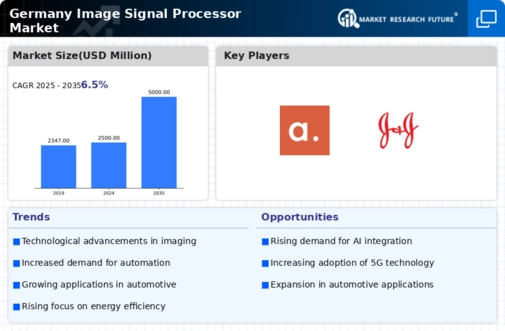Expansion of Consumer Electronics
The consumer electronics sector in Germany is witnessing a notable expansion, which is positively impacting the image signal-processor market. With the increasing popularity of high-definition displays and smart devices, the demand for advanced image processing solutions is on the rise. In 2025, the market for consumer electronics is expected to reach €30 billion, with a substantial portion allocated to image processing technologies. This growth is fueled by consumer preferences for high-quality imaging in smartphones, televisions, and cameras. As manufacturers strive to meet these demands, the image signal-processor market is likely to benefit from increased investments in research and development, leading to innovative products that enhance user experience.
Rising Adoption of AI Technologies
The integration of artificial intelligence (AI) technologies within the image signal-processor market is becoming increasingly prevalent in Germany. AI algorithms enhance image processing capabilities, enabling advanced features such as real-time object recognition and scene analysis. This trend is particularly evident in sectors like automotive and consumer electronics, where AI-driven image processing is essential for applications such as autonomous driving and smart cameras. The market for AI-enabled image signal processors was projected to grow at a CAGR of approximately 15% over the next five years, indicating a robust demand for these advanced solutions. As companies invest in AI technologies, the image signal-processor market is likely to experience significant growth, driven by the need for enhanced image quality and processing speed.
Surge in Demand for High-Resolution Imaging
The demand for high-resolution imaging solutions is surging in Germany, significantly influencing the image signal-processor market. Industries such as healthcare, automotive, and entertainment are increasingly relying on high-resolution imaging for applications ranging from medical diagnostics to enhanced visual experiences in gaming. The market for high-resolution imaging is projected to grow by 20% annually, reflecting a strong inclination towards superior image quality. This trend necessitates the development of advanced image signal processors capable of handling large data volumes and delivering real-time processing. Consequently, manufacturers are likely to focus on creating more efficient and powerful image signal processors to cater to this growing demand.
Growing Importance of Image Quality in Marketing
The emphasis on high-quality imagery in marketing strategies is becoming increasingly pronounced in Germany, thereby impacting the image signal-processor market. Businesses across various sectors are recognizing that superior image quality can significantly enhance brand perception and customer engagement. As a result, there is a growing demand for advanced image processing solutions that can deliver stunning visuals for advertising and promotional materials. The market for image processing in marketing is projected to grow by 18% over the next few years, indicating a robust opportunity for image signal processors. This trend suggests that companies will likely invest in high-performance image signal processors to ensure their marketing materials stand out in a competitive landscape.
Increased Investment in Research and Development
Investment in research and development (R&D) within the image signal-processor market is gaining momentum in Germany. Companies are recognizing the importance of innovation to stay competitive in a rapidly evolving technological landscape. In 2025, R&D spending in the electronics sector is expected to exceed €5 billion, with a significant portion directed towards image processing technologies. This investment is likely to lead to breakthroughs in image signal processing, including enhanced algorithms and improved hardware capabilities. As a result, the image signal-processor market is poised for growth, driven by the continuous pursuit of cutting-edge solutions that meet the demands of various industries.












Leave a Comment